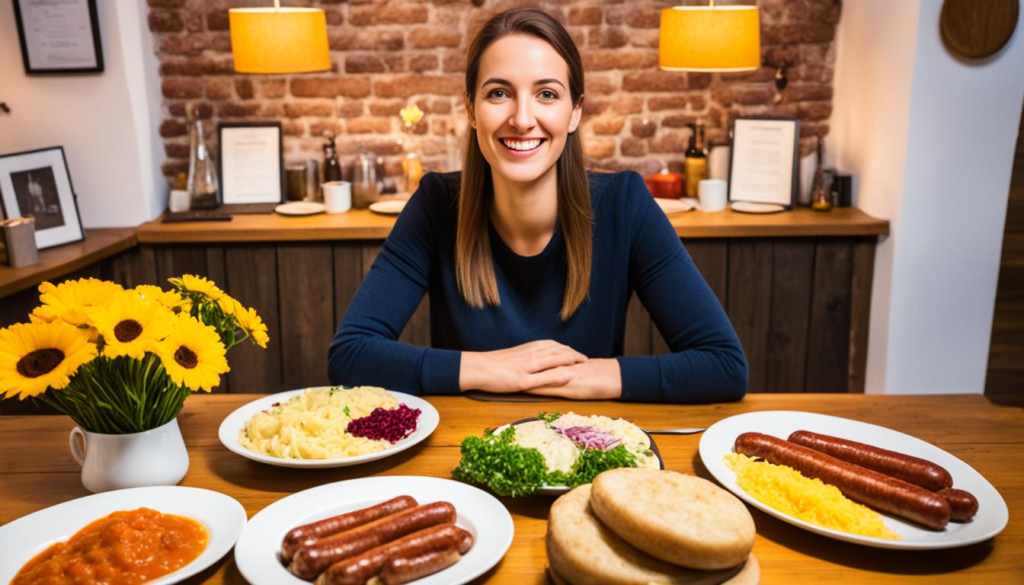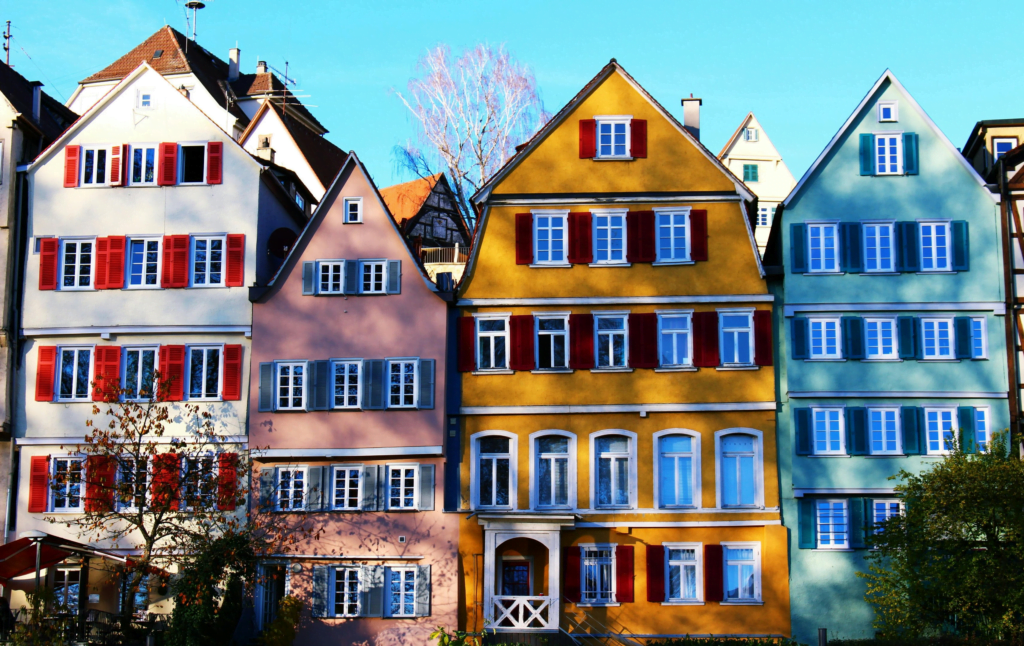
Germany is known for its rich cultural heritage, and food is an essential part of this experience. With a variety of traditional dishes that vary across regions, international students studying or visiting Germany should make it a point to explore the local cuisine. German food is hearty, flavorful, and often steeped in centuries-old traditions. From street snacks to elaborate meals, Germany offers a variety of culinary delights. This guide will walk you through must-try dishes and regional specialties, giving you complete insight into what to eat during your time in the country.
1. Bratwurst (Grilled Sausage)
One of the most iconic German foods, Bratwurst is a grilled sausage made from pork, beef, or veal. It is popular all over Germany and comes in many regional varieties. In Nürnberg (Nuremberg), the sausages are smaller and usually served three at a time with sauerkraut or potato salad. The Thuringian version, known as Thüringer Bratwurst, has a distinct flavor due to the addition of marjoram.
Many Germans enjoy Bratwurst as street food, typically served in a crusty bread roll with mustard. For international students, this quick meal is an affordable and tasty option, perfect for a snack between classes or while exploring the city.
2. Sauerbraten (Pot Roast)
Sauerbraten is considered one of Germany’s national dishes and is a must-try for those who enjoy slow-cooked meals. This dish consists of marinated beef (or sometimes pork, lamb, or horse meat), which is slowly roasted until tender. The marinade, made with vinegar, spices, and herbs, gives the meat a slightly tangy flavor. Sauerbraten is typically served with red cabbage, potato dumplings, or boiled potatoes.
The dish varies regionally, with slight differences in spices and marinades, but the end result is always a rich, flavorful meal. While it’s often found in traditional restaurants, some German families also make it during special occasions. If you want to experience the authentic flavor, seek out a local eatery offering this specialty.
3. Brezel (Pretzel)
The Brezel (or Pretzel) is a quintessential part of German food culture. This baked dough is recognizable by its knot-like shape, golden-brown crust, and soft, chewy interior. Pretzels are most commonly found in southern Germany, particularly in Bavaria, where they are typically enjoyed with mustard or alongside Weisswurst (white sausage).
International students will appreciate the availability of pretzels at bakeries, supermarkets, and train stations, making it an easy snack while on the go. Some varieties are topped with salt, cheese, or seeds, giving students several ways to enjoy this versatile bread.
4. Schnitzel (Breaded Cutlet)
Although Schnitzel originated in Austria, it has become a staple in German cuisine. A traditional Schnitzel is made by pounding pork or veal thin, coating it with breadcrumbs, and frying it until golden brown. The most popular version in Germany is the Wiener Schnitzel, which is served with lemon slices and a side of potato salad or fries.
For a twist, try Jägerschnitzel (hunter’s schnitzel) served with a mushroom cream sauce or Zigeunerschnitzel with bell pepper sauce. This dish is easy to find in restaurants and pubs, making it an excellent choice for students looking to try traditional German meals without breaking the bank.
5. Currywurst
A popular street food, Currywurst is a dish that combines sausage with a tangy curry-flavored ketchup. It was invented in Berlin and has since become an integral part of German food culture. Currywurst is typically served sliced and paired with fries or a bread roll.
For students visiting Berlin, sampling Currywurst from a local stand is essential. Some stands even offer vegan or vegetarian versions, ensuring everyone can try this iconic snack. It’s affordable, flavorful, and perfect for a quick bite while exploring the city.
6. Maultaschen (Stuffed Pasta)
Maultaschen are large pasta pockets filled with meat, spinach, breadcrumbs, and onions. They are often referred to as the German version of ravioli. This dish hails from the Swabian region in southern Germany, where it’s traditionally served in broth or pan-fried with onions and butter.
Maultaschen is a versatile dish that can be enjoyed as a soup or as a main course. Vegetarian versions filled with vegetables and cheese are also popular. This comforting dish is ideal for students looking for a filling meal during colder months.
7. Weißwurst (White Sausage)
Weißwurst, or white sausage, is a Bavarian specialty that international students should not miss. This sausage is made from a mixture of veal and pork, flavored with parsley, lemon, and spices. It is traditionally served in a bowl of hot water with a side of sweet mustard and a pretzel.
The proper way to eat Weißwurst is by peeling off the casing before eating the sausage. It is usually enjoyed before noon, as it is not typically consumed later in the day. For students visiting Munich or other parts of Bavaria, experiencing a traditional Weißwurst breakfast is a must.
8. Rouladen (Beef Rolls)
Rouladen is a classic German dish made by rolling thin slices of beef around a filling of mustard, onions, bacon, and pickles. The rolls are then browned and simmered in a rich gravy until tender. This dish is often served with red cabbage and potato dumplings, making it a hearty and satisfying meal.
Rouladen is usually reserved for special occasions and family gatherings, but many restaurants also offer it on their menus. International students looking to experience traditional German comfort food should definitely try this dish.
9. Käsespätzle (Cheese Noodles)
Käsespätzle is Germany’s answer to macaroni and cheese. It consists of soft egg noodles, or Spätzle, layered with melted cheese and topped with crispy fried onions. This dish is especially popular in the Swabian region and the southern parts of Germany.
Students will love Käsespätzle for its comforting, cheesy goodness. It’s often served in generous portions, making it a great meal for sharing with friends. Pair it with a crisp salad or a local beer for the ultimate German food experience.
10. Kartoffelsalat (Potato Salad)
Kartoffelsalat, or potato salad, is a staple side dish found throughout Germany, though its preparation varies by region. In southern Germany, it’s typically made with broth, vinegar, onions, and mustard, resulting in a tangy flavor. In northern Germany, the salad is creamier, with mayonnaise as the base.
Potato salad is commonly served with sausages, schnitzels, or as part of a barbecue spread. It’s an excellent option for students who enjoy lighter dishes or want to complement their main course with a traditional German side.
11. Schwarzwälder Kirschtorte (Black Forest Cake)
Germany is known for its desserts, and the Schwarzwälder Kirschtorte (Black Forest cake) is one of the most famous. This indulgent cake is made with layers of chocolate sponge, whipped cream, cherries, and a splash of cherry brandy.
International students with a sweet tooth should not miss the opportunity to try this delicious dessert. It’s commonly found in cafes and bakeries, making it easy to enjoy during a relaxing afternoon with friends.
12. Lebkuchen (Gingerbread)
If you are in Germany during the winter months, you must try Lebkuchen. This gingerbread-like treat is a Christmas specialty, often shaped like hearts or stars and decorated with icing. Nuremberg is particularly famous for its Lebkuchen, and you can find it at Christmas markets throughout the country.
Lebkuchen comes in different varieties, some soft and cake-like, while others are crunchy. They also make great souvenirs or gifts to take back home.
13. Apfelstrudel (Apple Strudel)
Another must-try dessert is Apfelstrudel, a pastry filled with spiced apples and raisins. This dessert originated in Austria but is also popular in Germany, especially in southern regions. It’s typically served warm with a dusting of powdered sugar and a side of vanilla sauce or ice cream.
Apfelstrudel makes for a delightful treat after a meal or as an afternoon snack while exploring Germany’s picturesque towns.
Conclusion
Germany offers a diverse range of dishes and regional specialties that cater to all tastes. Whether you prefer savory foods like Bratwurst, Sauerbraten, and Käsespätzle or have a sweet tooth for Black Forest cake and Apfelstrudel, there is something for everyone. For international students, exploring these dishes is not only an opportunity to enjoy delicious food but also a way to connect with German culture and traditions.
From street food to festive treats, the culinary landscape of Germany is vast and varied. Make sure to try these must-have dishes and enjoy the unique flavors that each region has to offer. Whether you’re on the go, dining out, or sharing meals with friends, German cuisine will undoubtedly leave a lasting impression.


